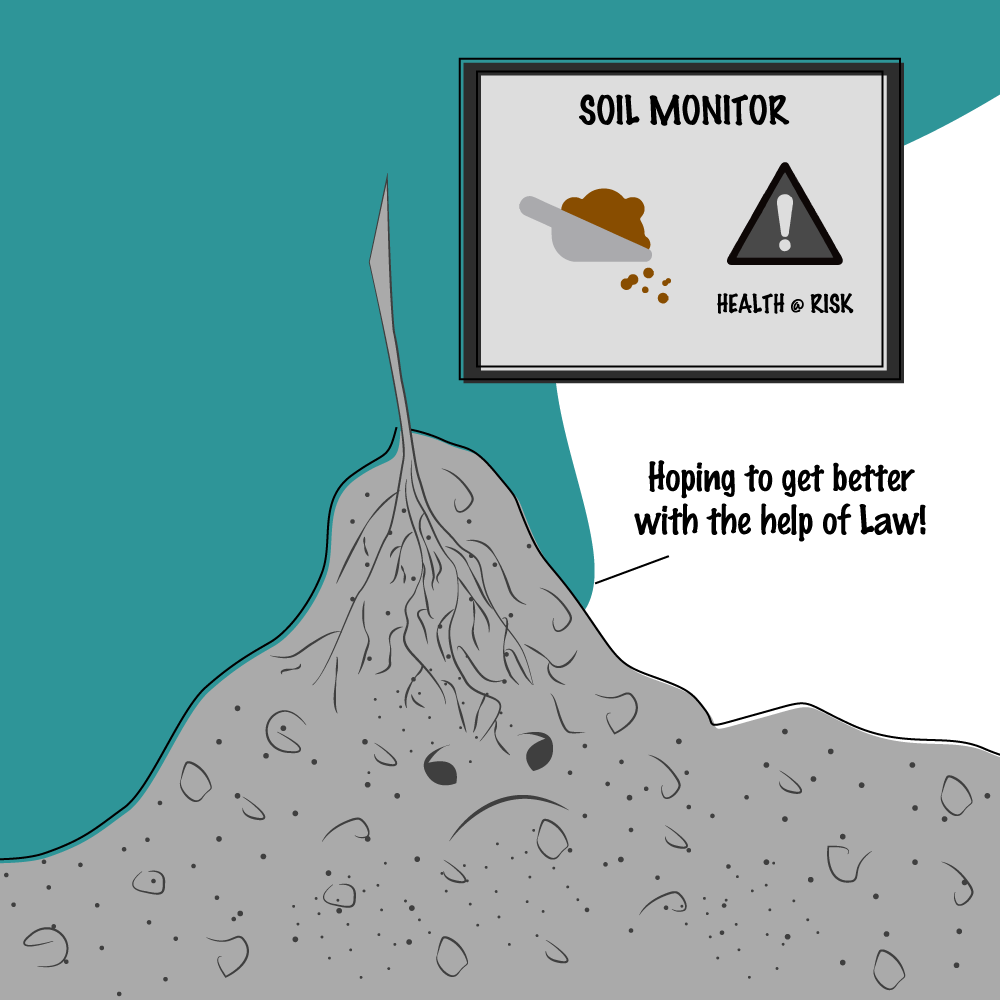The EU’s New Soil Health Monitoring Law

Recently, the European Commission (EC) has proposed a new law in order to deal with the health of soils to ensure that the soils are healthy.1
This Law has been proposed with the aim of achieving climate neutrality, a clean and circular economy, and stopping desertification and land degradation. Moreover, with this Law, the EC attempts to speed up the process of reversing biodiversity loss, providing healthy food, and safeguarding human health. As a result, the Soil Monitoring Law aims to provide a legal framework to help achieve healthy soils by 2050. Thus, the Law intends to address key issues pertaining to soil threats and its degradation of health, such as erosion, floods and landslides, loss of soil organic matter, salinisation, contamination, compaction, sealing, as well as loss of soil biodiversity.
This Law has been proposed by keeping in mind the scientific evidence which shows that approximately 60%2 of the European soils are unhealthy and are further degrading due to unsustainable management of the land, sealing, contamination and overexploitation, coupled with the impact of climate change and extreme weather events. The evidence additionally suggests that due to the degraded quality of soil present in the environment, there is a direct negative implication on the soil ecosystem services, including food, fibre, timbre, nutrient cycling, carbon sequestration, pest control or water regulation.
It is important to understand that soil is a vital, limited, non-renewable and irreplaceable resource. Hence, because of such a reduced and unhealthy soil ecosystem prevalent, European Union (EU) has to face an annual loss of more than 50 billion Euros3
Therefore, such law addresses this problem and is in itself one of the first focused attempts to tackle the problem of climate change in a more organised manner. As a result, the Law focuses on three particular elements by providing measures on: (a) monitoring and assessment of soil health; (b) sustainable soil management; and (c) contaminated sites.
Key features of the Law4
- Governance requirements
Article 4 and 5 of the Directive deals with the establishment of a governance monitoring layout. As per Article 4, each member state must establish a soil district within their country. The role of the soil district would be to manage the soils and to fulfil the directions of this Law within their territory. Further, Article 5 warrants the appointment of competent authorities by the member state who would be responsible bodies to work towards the mandate of this Law. Thus, these authorities would act as a body to bring this Law into compliance. Hence, through these provisions, the individualistic and task-oriented focus would be provided to fulfil the multiple objectives of this Law.
- Monitoring and assessment of soil health framework
The Law deals with providing the monitoring framework based on the soil districts that will help in ensuring that the soil health of their territory is regularly monitored. According to Article 6, it is the obligation of the member state to establish a monitoring framework whose duty would be to ensure that regular and accurate monitoring of soil health is carried out in their region. Such a monitoring framework would consist of certain parameters, which are provided in the further Articles. These Articles include parameters such as the soil descriptors and soil health criteria referred to in Article 7; the soil sampling points determined in accordance with Article 8(2); the land take and soil sealing indicators referred to in Article 7(1); the remote sensing data and products referred to in paragraph 5 of this Article; and the soil measurement carried out by the Commission in accordance with paragraph 4 of this Article.
Further, it is the parallel duty of the EC to carry out regular soil measurements on soil samples taken in situ based on the relevant descriptors and methodologies to support the mandate of Member States’ monitoring of soil health. Moreover, EC is also obligated to establish a digital soil health data portal that shall provide access to at least the available soil health data within two years from the date of this Directive coming into force. Hence, this Law is a step towards continuous monitoring of the soil health situation within the territories to ensure that the appropriate data can be brought before the competent authorities and to measure the progress in the nurturing of soil health within due course. The assessment part of the soil health is the main crux of this Directive, as the member states are under the obligation to assess the soil health based on the data collected according to the established framework every five years. Based on the assessment and the parameters provided, member states have to find out whether the soil is healthy or not; and issue the process of certification of soil health for its usage.
- Sustainable Soil management practices
Article 10 of the Directive lays down sustainable soil management principles that aim to maintain or enhance soil health. According to this Article, member states, within the four years of this Directive coming into force, must define sustainable soil management practices which are to be gradually implemented on all managed soils. Moreover, it is the duty of member states to promote awareness of the medium- and long-term multiple benefits of sustainable soil management and the need to manage soils in a sustainable manner. Additionally, new holistic soil management concepts must be researched and implemented. Even more, it is the obligation of the member state to regularly update the mapping of available funding instruments and activities to support the implementation of sustainable soil management. Such soil management practices must be continuously assessed, reviewed, and revised to ensure that they are effective in nature.
- Contaminated Sites
Article 12 of the Directive deals with setting an overarching obligation to take a risk-based approach to identifying, investigating, and managing potentially contaminated sites. It is the obligation of the member states to manage the risks for human health and the environment of potentially contaminated sites and keep them to acceptable levels, taking account of the environmental, social and economic impacts of the soil contamination. In regard to identifying the potentially contaminated sites, Article 13 states that it is mandatory for member states to systematically and actively identify all sites where soil contamination is suspected based on evidence collected through all available means. In addition to this, Article 14 states that each member states, after identifying the contamination sites, must ensure that all potentially contaminated sites identified are subject to soil investigation. Based on the investigation, Article 15 clearly provides that each state has to lay down the specific methodology for determining the site-specific risks of contaminated sites and to define what constitutes an unacceptable risk for human health and the environment resulting from contaminated sites by taking into account existing scientific knowledge, the precautionary principle, local specificities, and current and future land use. Thus, the objective is to assess which particular site poses unacceptable risks for human health or the environment, and according to that assessment, member states have to look for reduction measures which are to be activated so that risks are brought to an acceptable level for human health and the environment.
- Penalties
This Directive further provides the provision of imposing penalties. As per Article 23, the member States have to lay down the rules on penalties which are applicable to violations, by humans or even the legal identities, of the national provisions adopted with respect to this Directive and shall ensure that those rules are implemented. The penalties which are to be imposed should not be unjust. Instead, they should be effective, proportionate and dissuasive. Resultantly, the fine has to be calculated in such a manner that it is considered to be effective in depriving the person responsible for the violation of the economic benefits derived from that violation for which he/she would be penalised. Moreover, while imposing the penalty, due regard should be given to factors such as nature, extent and gravity of the violation, whether the act was intentional or it was mere negligence, etc.
Conclusion
The current proposed Directive is a much-needed step to deal with the prevalent problem of climate change. Till now, not many individualistic efforts have been made to address the problem of climate change. However, with this Directive, there is a sincere and focused attempt to tackle the problem, which will help in mitigating the problem as well as reversing the damage which has already been caused. With the collaborated efforts of the member states, efforts can be put into the restoration of soils to a healthy level so that the risk of climate change and land degradation can be highly mitigated. Thus, such an initiative is a crucial centrepiece to achieve climate neutrality, resilient nature and biodiversity, zero pollution, sustainable food systems, human health and well-being. Moreover, with the implementation of this Directive as well as compliance with its provision, such law can be set as a benchmark for other countries to adopt similar practices so that the climate problem can be collaboratively tackled. At this stage, it is worth seeing the future of such a Directive and the outcome of its implementation with respect to the improvement of soil health.
References
| ↑1 | https://ec.europa.eu/commission/presscorner/detail/en/qanda_23_3637. |
| ↑2 | European Commission, Directorate-General for Research and Innovation, Veerman, C., Pinto Correia, T., Bastioli, C., et al., Caring for soil is caring for life. Ensure 75% of soils are healthy by 2030 for food, people, nature and climate : report of the Mission board for Soil health and food, Publications Office, 2020, https://data.europa.eu/doi/10.2777/821504. |
| ↑3 | https://ec.europa.eu/commission/presscorner/detail/en/fs_23_3638. |
| ↑4 | https://environment.ec.europa.eu/system/files/2023-07/Proposal%20for%20a%20DIRECTIVE%20OF%20THE%20EUROPEAN%20PARLIAMENT%20AND%20OF%20THE%20COUNCIL%20on%20Soil%20Monitoring%20and%20Resilience_COM_2023_416_final.pdf. |

